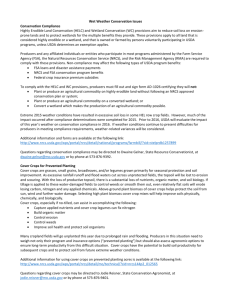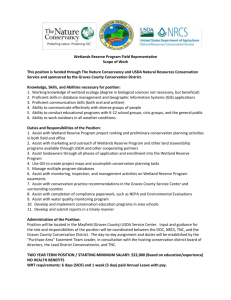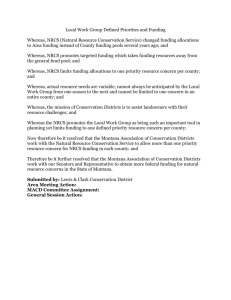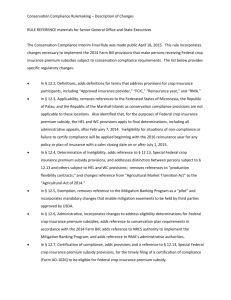Fact Sheet - Conservation Compliance - OC Cleared
advertisement
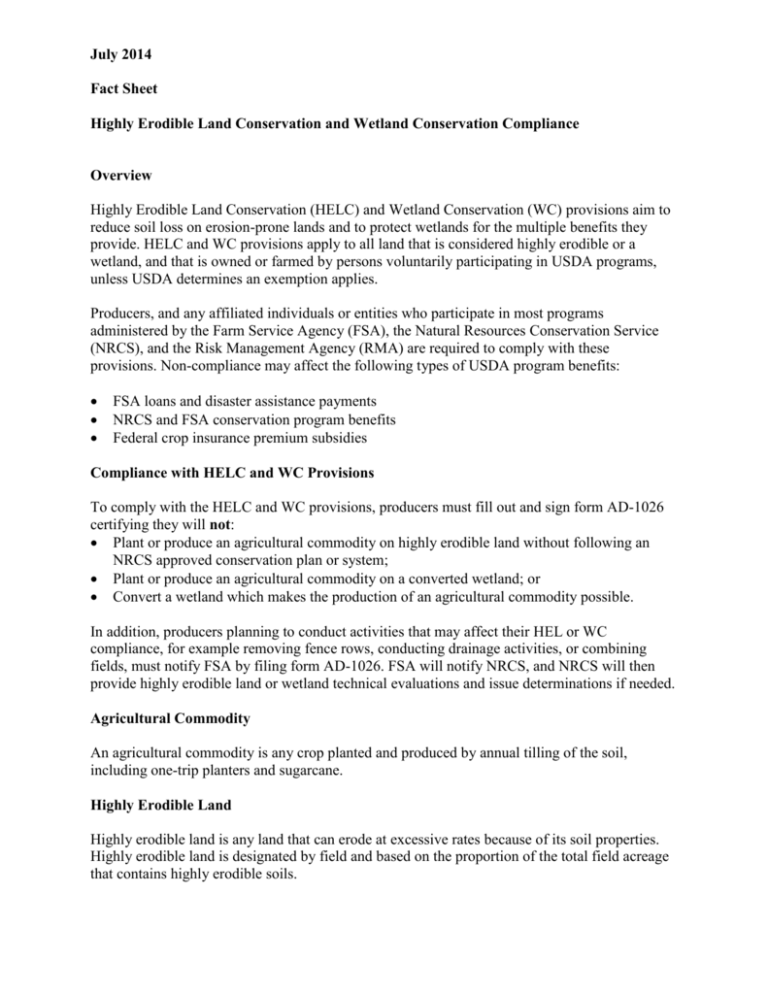
July 2014 Fact Sheet Highly Erodible Land Conservation and Wetland Conservation Compliance Overview Highly Erodible Land Conservation (HELC) and Wetland Conservation (WC) provisions aim to reduce soil loss on erosion-prone lands and to protect wetlands for the multiple benefits they provide. HELC and WC provisions apply to all land that is considered highly erodible or a wetland, and that is owned or farmed by persons voluntarily participating in USDA programs, unless USDA determines an exemption applies. Producers, and any affiliated individuals or entities who participate in most programs administered by the Farm Service Agency (FSA), the Natural Resources Conservation Service (NRCS), and the Risk Management Agency (RMA) are required to comply with these provisions. Non-compliance may affect the following types of USDA program benefits: FSA loans and disaster assistance payments NRCS and FSA conservation program benefits Federal crop insurance premium subsidies Compliance with HELC and WC Provisions To comply with the HELC and WC provisions, producers must fill out and sign form AD-1026 certifying they will not: Plant or produce an agricultural commodity on highly erodible land without following an NRCS approved conservation plan or system; Plant or produce an agricultural commodity on a converted wetland; or Convert a wetland which makes the production of an agricultural commodity possible. In addition, producers planning to conduct activities that may affect their HEL or WC compliance, for example removing fence rows, conducting drainage activities, or combining fields, must notify FSA by filing form AD-1026. FSA will notify NRCS, and NRCS will then provide highly erodible land or wetland technical evaluations and issue determinations if needed. Agricultural Commodity An agricultural commodity is any crop planted and produced by annual tilling of the soil, including one-trip planters and sugarcane. Highly Erodible Land Highly erodible land is any land that can erode at excessive rates because of its soil properties. Highly erodible land is designated by field and based on the proportion of the total field acreage that contains highly erodible soils. Producers who produce agricultural commodities on land identified as highly erodible are required to farm such land in accordance with a conservation plan or system that is approved by NRCS and that substantially reduces soil loss. Producers proposing to produce agricultural commodities on highly erodible land that has no crop history prior to Dec. 23, 1985, (known as Sodbusting) are required to farm such land in accordance with a conservation plan or system that provides for no substantial increase in soil erosion. A conservation plan or system to reduce soil erosion is not required for land that is not highly erodible. Wetland A wetland is an area that: Has a predominance of hydric soils (wet soils); Is inundated or saturated by surface or groundwater (hydrology) at a frequency and duration sufficient to support a prevalence of hydrophytic (water tolerant) vegetation typically adapted for life in saturated soil conditions and Under normal circumstances supports a prevalence of such vegetation except that this term does not include lands in Alaska identified as having a high potential for agricultural development and a predominance of permafrost soils. NRCS and FSA Roles in Making Determinations When making HELC and WC compliance determinations: NRCS responsibilities include: o For HELC compliance: o Making highly erodible determinations; o Working with producers to develop conservation plans and systems; and o When required, determining if highly erodible land is being farmed in accordance with a conservation plan or system approved by NRCS. o For WC compliance: o Making wetland determinations, including establishing if certain technical exemptions apply, such as prior converted cropland; and o Determining if a wetland conversion has occurred. FSA makes eligibility determinations, such as who is ineligible based upon NRCS technical determinations of HELC or WC non-compliance. FSA also acts on requests for the application of certain eligibility exemptions, such as the good faith relief exemption. Highly Erodible Land and Wetland Identification FSA maintains the official USDA records of highly erodible land and wetland determinations. The determinations are recorded within the geographic information system and the automated farm and tract records maintained by FSA; however, it is important to know that determinations may not include all of the producer's land. Producers may obtain aerial imagery of their farms and a printout of their farm and tract records from the FSA office servicing their farm. If a producer is uncertain of the highly erodible land and wetland determinations applicable to their land, the producer should contact the appropriate USDA Service Center for assistance. The following link will help in locating local USDA Service Centers: http://offices.sc.egov.usda.gov/locator/app. HELC and WC Non-Compliance The 2014 Farm Bill re-established the applicability of the HELC and WC provisions to crop insurance subsidies. The Act made no change in HELC and WC implementation with respect to NRCS and FSA programs. FSA and NRCS Programs Producers who are not in compliance with HELC and WC provisions are not eligible to receive benefits for most programs administered by FSA and NRCS. If a producer received program benefits and is later found to be non-compliant, the producer may be required to refund all benefits received and/or may be assessed a penalty. In particular, unless specific exemptions apply, a producer participating in FSA and NRCS programs must be in compliance with an NRCS approved conservation plan or system for all highly erodible land used for agricultural commodity production; not have planted or produced an agricultural commodity on a wetland converted after Dec. 23, 1985; and after Nov. 28, 1990, must not have converted a wetland making the production of an agricultural commodity possible on such converted wetland. A producer who violates HELC or WC provisions is ineligible for applicable FSA and NRCS benefits for the year(s) in violation. A planting violation, whether on highly erodible land or a converted wetland, results in ineligibility for benefits for the year(s) when the planting occurred. A wetland conversion violation results in ineligibility beginning with the year in which the conversion occurred and continuing for subsequent years, unless the converted wetland is restored or mitigated before January 1 of the subsequent year. HELC and WC Non-Compliance - Risk Management Agency – Policies Reinsured by the Federal Crop Insurance Corporation Producers obtaining federally reinsured crop insurance will not be eligible for any premium subsidy paid by the Federal Crop Insurance Corporation (FCIC) for any policy or plan of insurance if the producer: Has not filed an accurately completed AD-1026 with FSA certifying compliance with HELC and WC provisions; or Is not in compliance with HELC and WC provisions. Unless specific exemptions apply, a producer must: Be in compliance with a NRCS-approved conservation plan for all highly erodible land; Not plant or produce an agricultural commodity on a wetland converted after Feb. 7, 2014; and Not have converted a wetland after Feb. 7, 2014, to make possible the production of an agricultural commodity. A producer is ineligible for any premium subsidy paid by FCIC on all policies and plans of insurance for the reinsurance year(s) (July 1 – June 30) following the reinsurance year of a final determination of a violation of HELC or WC provisions, including all administrative appeals, unless specific exemptions apply. Further, a producer will be ineligible for any premium subsidy paid by FCIC on all policies and plans of insurance for the reinsurance year if they do not have a completed form AD-1026 on file with FSA certifying compliance on or before June 1 prior to the beginning of the subsequent reinsurance year (July 1), unless otherwise exempted. Regaining Eligibility for Benefits Lost Because of a Violation Producers who are found to be in violation of HELC or WC provisions, but acted in good faith and without the intent to violate, may file a request to regain eligibility for the period in violation at the FSA office where their farm records are administered. If the request is approved, producers are required to take corrective action within an established period. There are exemptions that may apply in limited circumstances. Additional Information For additional information on HELC and WC compliance, contact the FSA office or the NRCS office at a local USDA Service Center. Additional information can be found online at www.fsa.usda.gov for FSA, www.nrcs.usda.gov for NRCS and www.rma.usda.gov for RMA. The regulations covering these provisions are set forth in the Code of Federal Regulations at 7 CFR Part 12. The U.S. Department of Agriculture (USDA) prohibits discrimination in all of its programs and activities on the basis of race, color, national origin, age, disability, and where applicable, sex, marital status, familial status, parental status, religion, sexual orientation, political beliefs, genetic information, reprisal, or because all or part of an individual's income is derived from any public assistance program. (Not all prohibited bases apply to all programs.) Persons with disabilities who require alternative means for communication of program information (Braille, large print, audiotape, etc.) should contact USDA's TARGET Center at (202) 720-2600 (voice and TDD). To file a complaint of discrimination, write to USDA, Assistant Secretary for Civil Rights, Office of the Assistant Secretary for Civil Rights, 1400 Independence Avenue, S.W., Stop 9410, Washington, DC 20250-9410, or call toll-free at (866) 632-9992 (English) or (800) 877-8339 (TDD) or (866) 377-8642 (English Federal-relay) or (800) 845-6136 (Spanish Federal-relay). USDA is an equal opportunity provider and employer.
